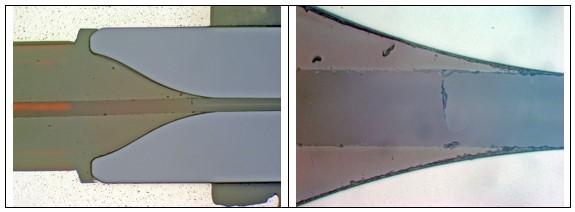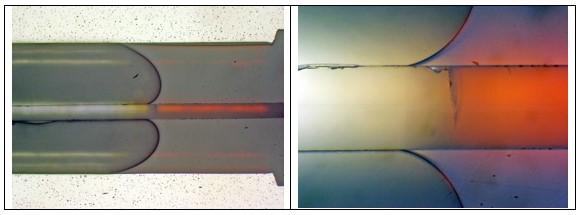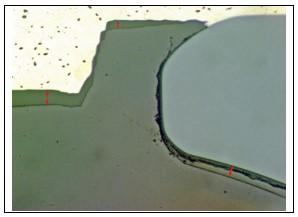How many times have you asked yourself: Why did this connector fail? I’ve been in the fiber optic industry since the 1980’s and – despite amazing technological advances – this issue continues to plague our industry.
Did you know there are 4 diagnostic methods that can help to troubleshoot why a connector failed? As you can guess from the title of this article, my favorite diagnostic method is cross-sectioning connectors. This technique enables us to actually look inside a fiber optic connector, see the defect, and pinpoint the cause of failure.
Let’s look at an example…
Here are photos I took while cross-sectioning a connector for a Fiber Optic Center customer. The connector was first subjected to vacuum impregnation with a metallographic grade epoxy. It was then sectioned to various locations, ending at the approximate longitudinal midpoint of the fiber in the ceramic ferrule.
Cross-sectioning enables us to zero in on a particular area of the fiber optic connector assembly to determine the potential defect. While analyzing this cross-sectioned connector, I found several partial fiber fractures in critical areas, along with one complete fiber fracture.

In these magnified images of this connector, notice the partial fracture of the fiber in a critical location.

Here are additional magnified images of the same connector. Notice the partial fracture of the fiber at the extent of the fiber bonding epoxy.

In the same fiber optic connector, the fiber bonding epoxy exhibits significant shrinkage, as evidenced by gaps between the epoxy and internal connector surfaces. In the image above, note the obvious shrinkage of the fiber bonding epoxy at the red arrows.
Cross-sectioning is an effective diagnostic tool – a practical solution to identify process issues, which can lead to problem resolution.
As you can see from the above photos, cross-sectioning offers the unique ability to identify and isolate problems related to fiber optic terminations – issues that would otherwise be invisible. Fiber Optic Center’s cross-sectioning service can reveal breaks, nicks, microbends, pinches, and microfractures in the fiber; insufficient/excess epoxy or bubbles in the epoxy; and issues with improper stripping, crimping, and so forth.
When fiber optic connectors fail, cross-sectioning can help to determine the cause and identify process issues. Fiber Optic Center’s customers rely on this diagnostic service to visually analyze their connectors, identify defects, diagnose potential causes, and implement process improvements.
When you implement a cross-sectioning capability IN-HOUSE, this enables you to conduct routine audits and rapid failure analysis.
I encourage you to consider implementing a cross-sectioning capability in-house, in your own testing environment. We can help you set up the equipment, then train you to perform the test and interpret results. When questions arise, you can call us – we’re a resource you can count on.
When you implement this capability in-house, you can perform routine cross-sectioning to monitor the quality of your fiber optic cable assemblies. Plus, in a matter of hours, you can conduct rapid failure analysis to immediately resolve issues.
Learn more details in my technical article, Cross-Sectioning Fiber Optic Connectors: An Effective Diagnostic Method to Identify Defects and Resolve Process Issues. Click HERE to read and learn more about:
- The 4 diagnostic methods available to understand why a connector failed:
- In-house optical diagnostic process and tools
- X-ray inspection services
- Sonar/ultrasonic inspection services
- Cross-sectioning services
- Details and photos showing how a connector is cross-sectioned at Fiber Optic Center
- More information about how an in-house cross-sectioning capability empowers you to conduct routine audits and rapid failure analysis
- 5 common connector issues and recommended diagnostic methods to resolve those issues:
- Connectors with high Return Loss
- Connectors with no light transmission
- Connectors with intermittent and non-repeatable readings
- Connectors that do not meet manufacturer minimum optical specifications
- Connectors with latent defects



